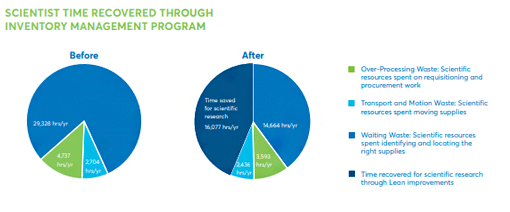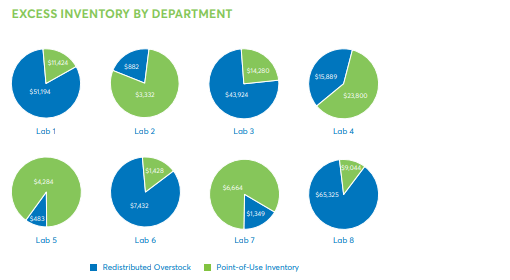Program Recovers Time for Research
Challenge
In order to remain competitive and increase shareholder value, a Fortune 500 pharmaceutical company identified the need to increase the productivity of their scientists, who were spending significant amounts of time away from their research as they managed their own lab supply inventory.
The company engaged a Avantor Services Lean Process Consultant to conduct a detailed assessment, and it was revealed that scientists were spending 36,770 hours per year searching for supplies, writing purchase orders, reconciling invoices, and returning unneeded items. Now that the problem was identified, what measures could be taken to recover time from inventory management and help the company achieve its objective?
Solution
Our consultant recommended a point-of-use inventory management program to stock the right products in the right amounts at each scientist’s work area. This program identifies and concentrates the supplies needed for each lab based on historical purchasing data and interviews with the scientists. The team also implemented industry-leading inventory management technology to track usage and continually optimize stocking levels.
The consultant also recommended changes to the procurement process, such as assigning a single point of contact for infrequently ordered items, streamlining channels for handling procurement issue resolution, and deploying expert support for custom sourcing projects.

Figure 1. Summary of results from Lean business process assessment time studies
Result
Thousands of hours previously wasted on non-essential tasks have been recaptured for scientific work. Currently, the program is saving 16,077 hours per year, the equivalent of 8.03 full-time scientists.
The point of use program removed excess inventory valued at $74,256, and redistributed the overstock supplies appropriately. The dollar value of average on-hand lab supplies at the facility has decreased 29%, from $521,000 to $373,000. Excess inventory is no longer a factor, and the amount of space available for research and upgraded, high-tech instruments has increased without expanding the lab’s footprint.

Figure 2. The inventory in each of the eight departments was assessed and optimized based on the specific needs at each point of use. Excess inventory (overstock) was then redistributed to other departments appropriately.